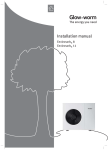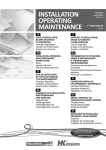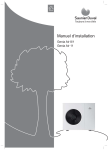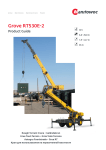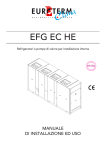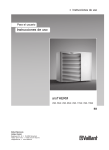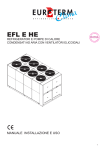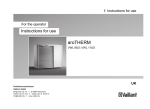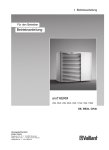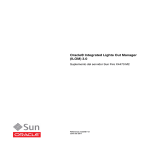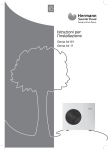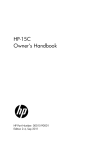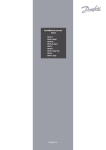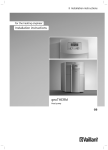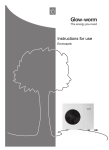Download Installation manual aroTHERM installation and service manual Size
Transcript
Installation instructions For the competent person Installation instructions aroTHERM VWL 55/2 A 230 V; VWL 85/2 A 230 V; VWL 115/2 A 230 V; VWL 155/2 A 230 V UK Publisher/manufacturer Vaillant GmbH Berghauser Str. 40 D-42859 Remscheid Telefon 021 91 18‑0 Telefax 021 91 18‑28 10 [email protected] www.vaillant.de Contents Contents 7.4 Yearly maintenance ............................................. 25 7.5 Cleaning the product............................................ 26 1 Safety .................................................................... 3 7.6 Draining the product ............................................ 26 1.1 Action-related warnings ......................................... 3 7.7 Checking the product's status codes ................... 27 1.2 Required personnel qualifications ......................... 3 7.8 Checking the electrical installation ...................... 27 1.3 General safety information .................................... 3 7.9 Start-up following maintenance ........................... 27 1.4 Regulations (directives, laws, standards) .............. 4 8 Troubleshooting ................................................ 27 1.5 CE label ................................................................. 4 8.1 Troubleshooting ................................................... 27 1.6 Approvals............................................................... 5 8.2 Fault codes .......................................................... 27 1.7 Local regulations.................................................... 5 8.3 Carrying out the actuator test .............................. 27 1.8 Regulations............................................................ 5 9 Decommissioning.............................................. 28 1.9 Other regulations ................................................... 5 9.1 Temporary decommissioning .............................. 28 1.10 Intended use .......................................................... 6 9.2 Permanently decommissioning............................ 28 2 Notes on the documentation .............................. 7 10 Vaillant customer service ................................. 28 2.1 Observing other applicable documents ................. 7 10.1 Customer service................................................. 28 2.2 Storing documents................................................. 7 11 Disposal.............................................................. 28 2.3 Applicability of the instructions .............................. 7 11.1 Recycling and disposal ........................................ 28 3 System overview.................................................. 7 11.2 Arranging disposal of coolant .............................. 28 3.1 Safety devices ....................................................... 7 Appendix ............................................................................ 29 3.2 Design of the heat pump system ........................... 7 A Overview of accessories................................... 29 3.3 Functionality........................................................... 7 B System diagrams ............................................... 30 3.4 System diagram (VWL 55/2 A 230 V).................... 8 B.1 System diagram 8 E ............................................ 30 3.5 System diagram (VWL 85/2 A 230 V, VWL 115/2 A 230 V, VWL 155/2 A 230 V) ..................... 8 B.2 System diagram 8 F............................................. 32 B.3 System diagram 10 B .......................................... 34 4 Overview of the equipment................................. 9 B.4 System diagram 12 A .......................................... 36 4.1 Type designation and serial number ..................... 9 C Wiring diagrams................................................. 37 4.2 Information on the identification plate.................... 9 C.1 Wiring diagram 8 E .............................................. 37 5 Assembly and installation .................................. 9 C.2 Wiring diagram 8 F .............................................. 38 5.1 Preparing for fitting and installation ....................... 9 C.3 Wiring diagram 10 B ............................................ 39 5.2 Carrying out the installation ................................. 14 C.4 Wiring diagram 12 A ............................................ 40 5.3 Hydraulics installation .......................................... 14 D Heat pump schematic........................................ 41 5.4 Carrying out the electrical installation.................. 17 D.1 5.5 Connection diagrams........................................... 19 Heat pump schematic drawing (VWL 55/2 A 230 V) .................................................................. 41 6 Start-up ............................................................... 21 D.2 6.1 Run the start-up ................................................... 21 Heat pump schematic drawing (VWL 85/2 A 230 V) .................................................................. 42 6.2 Heat pump operating concept ............................. 21 D.3 6.3 Running through the installation assistant........... 21 Heat pump schematic drawing (VWL 115/2 A 230 V) .................................................................. 43 6.4 Calling up Live Monitor (checking status codes) .................................................................. 21 D.4 Heat pump schematic drawing (VWL 155/2 A 230 V) .................................................................. 44 6.5 Calling up statistics .............................................. 21 E Heat pump setting parameters ......................... 44 6.6 Filling the heating circuit ...................................... 21 F Technical data.................................................... 45 6.7 Preparing the heating water ................................ 22 G Overview of fault codes .................................... 48 6.8 Filling the heating installation .............................. 23 6.9 Activating the heat pump ..................................... 23 6.10 Checking the product's operation ........................ 23 6.11 Operating noises.................................................. 23 6.12 Adjusting the heating circuit................................. 23 6.13 Installing the side cladding .................................. 25 6.14 Instructing the operator........................................ 25 7 Maintenance ....................................................... 25 7.1 Observing maintenance intervals ........................ 25 7.2 Preparing for maintenance .................................. 25 7.3 Instructions before carrying out maintenance work ..................................................................... 25 2 Index ................................................................................... 51 Installation instructions aroTHERM 0020147164_04 Safety 1 1 1.1 Safety Action-related warnings Classification of action-related warnings The action-related warnings are classified in accordance with the severity of the possible danger using the following warning signs and signal words: Warning symbols and signal words Danger! Imminent danger to life or risk of severe personal injury Danger! Risk of death from electric shock Warning. Risk of minor personal injury Caution. Risk of material or environmental damage 1.2 Required personnel qualifications ▶ Secure against being switched back on again. ▶ Wait for at least 3 minutes until the condensers have discharged. ▶ Check that there is no voltage. ▶ Cover or insulate adjacent live parts. 1.3.3 Risk of death due to lack of safety devices A lack of safety devices (e.g. expansion relief valve, expansion vessel) may lead to potentially fatal scalding and other injuries, e.g. due to explosions. The schematic drawings included in this document do not show all safety devices required for correct installation. ▶ Install the necessary safety devices in the system. ▶ Inform the operator about the function and position of the safety devices. ▶ Observe the applicable national and international laws, standards and guidelines. Improper work carried out on the product 1.3.4 Risk of being scalded by hot may cause material damage to the complete drinking water installation and, as a consequence, may even There is a risk of scalding at the hot water cause personal injury. draw-off points if the hot water temperatures ▶ You should therefore only work on the are greater than 50 °C. Young children and product if you are an authorised competent elderly persons are particularly at risk, even person. at lower temperatures. 1.3 General safety information 1.3.1 Danger caused by improper operation Improper operation may present a danger to you and others, and cause material damage. ▶ Select the temperature so that nobody is at risk. 1.3.5 Risk of injury or material damage due to incorrect handling of the product ▶ Carefully read the enclosed instructions and all other applicable documents, particularly the "Safety" section and the warnings. Using the fins on the front side of the product as conductors may lead to injuries (due to falling) or to material damage. 1.3.2 Risk of death from electric shock 1.3.6 Risk of material damage due to additional elements in the heating water There is a risk of death from electric shock if you touch live components. Before commencing work on the product: ▶ Disconnect the product from the power supply (electrical partition with a contact opening of at least 3 mm, e.g. fuse or power switch). 0020147164_04 aroTHERM Installation instructions ▶ Do not use the fins as conductors. Unsuitable frost and corrosion protection agents may damage seals and other components of the heating circuit and may therefore also lead to leaks in the water outlet. ▶ Only add approved frost and corrosion protection agents to the heating water. 3 1 Safety 1.3.7 Risk of material damage caused by using an unsuitable tool 1.4 ▶ Use the correct tool to tighten or loosen screw connections. As part of the installation, commissioning and operation of the heat pump and the DHW storage you must take into account the current versions of the following regulations or standards, along with any local directives or guidelines that may apply. 1.3.8 Avoid environmental damage caused by escaping coolant The heat pump contains R410A coolant. The coolant must not be allowed to escape into the atmosphere. R410A is a fluorinated greenhouse gas covered by the Kyoto Protocol, with a GWP of 1725 (GWP = Global Warming Potential). If it escapes into the atmosphere, its impact is 1725 times stronger than the natural greenhouse gas CO2. – – – – – Before the heat pump is disposed of, the coolant it contains must be completely drained into a suitable vessel so that it can then be recycled or disposed of in accordance with the regulations. – ▶ Ensure that only officially certified competent persons with appropriate protective equipment carry out maintenance work on the coolant circuit or access it. ▶ Arrange for the coolant contained in the product to be recycled or disposed of by accredited specialists in accordance with regulations. ▶ Only use coolant R410A. ▶ Only use a suitable R410A tool for the filling, pressure measurement, vacuum generation and discharge. ▶ Solder the lines using shielding gas. Check the lines for leak-tightness using nitrogen. ▶ In the event of a repair or maintenance work, fill the coolant circuit with liquid coolant. ▶ If the coolant circuit is not leak-tight, check which component must be repaired or replaced. ▶ Lower the negative pressure in the coolant circuit to max. 10 mbar (1000 Pa). ▶ When filling the coolant circuit, observe the values in the "Technical data" section. – 4 – – – – Regulations (directives, laws, standards) Electricity at work act. Health and safety at work act. Relevant Utility supplier’s regulations. Water regulations and by-laws. Environment agency and local council requirements regarding bore holes, water courses, or noise levels. Gas safety installation and use regulations concerning any associated gas fired heat source used within the heating system. Building regulations part “L&P” and directives concerning energy saving. Building regulations such as G3 covering Hygiene and L8 Legieonella. COSHH regulations. Other relevant bodies such as HETAS and OFTEC. BS7671 requirements for electrical installations. All other national and regional relevant regulations for the installation of heat pumps and heating systems must be followed. 1.5 CE label The CE label shows that the products comply with the basic requirements of the applicable directives as stated on the identification plate. The declaration of conformity can be viewed at the manufacturer's site. Installation instructions aroTHERM 0020147164_04 Safety 1 1.6 Approvals This product has been fully tested in accordance with: – BS EN 14511:2011 1.7 1.8.2 Standards On installing and commissioning the appliance you must adhere to the technical rules, standards and provisions in eff ect at the time. Local regulations 1.8.3 Reminder of existing regulatory acts Benchmark places responsibilities on both manufacturers and installers. The purpose is – EC regulation No. 20372000 from the 29th of June 2000 This European regulation reto ensure that customers are provided with peals regulation No. 3093/94 and presents the correct equipment for their needs, that it the elimination schedules of CFC and is installed, commissioned and serviced in HCFC. It also deals with the collection of accordance with the manufacturer’s instrucrefrigerants, system leaks, particularly systions by a competent person approved at the tems containing more than 3 kg of CFC time by the Health and Safety Executive and or HCFC, as well as the minimum level of that it meets the requirements of the approqualifi cation required by the technicians. priate Building Regulations. The Benchmark Checklist can be used to demonstrate compli- – EC regulation No. 0842/2006 from the 17th of May 2006 regarding the containment, ance with Building Regulations and should be use, collection and disposal of the fl uorinprovided to the customer for future reference. ated greenhouse gases, the labelling and Installers are required to carry out installation, elimination of the products and equipment commissioning and servicing work in accordcontaining these gases, the restriction of ance with the Benchmark Code of Practice use and banning of certain products from which is available from the Heating and Hotthe market, as well as the training and cerwater Industry Council who manage and protifi cation of personnel and companies opmote the Scheme. erating in the activities targeted by this regulation: refrigeration, air-conditioning, heat pumps and fi re protection systems containing greenhouse gases. 1.9 Visit www.centralheating.co.uk for more information. Planning consent and Building works notification should be submitted either to Building Control or to a Competent Person Provider. 1.8 Regulations 1.8.1 Statutory requirements Where no British Standards exists, materials and equipment should be fi t for their purpose and of suitable quality and workmanship. Other regulations 1.9.1 Control of Substances Hazardous to Health Under Section 6 of The Health and Safety at Work Act 1974, we are required to provide information on substances hazardous to health. The adhesives and sealants used in this appliance are cured and give no known hazard in this state. The refrigerant used in this appliance is R410a the use of which is strictly controlled by F Gas regulation EN842/2006. The installation of this appliance must be carried out by a competent person in accordance the rules in force in the countries of destination. Manufacturer’s instructions must not be taken as overriding statutory requirements. 0020147164_04 aroTHERM Installation instructions 5 1 Safety 1.10 Intended use There is a risk of injury or death to the user or others, or of damage to the product and other property in the event of improper use or use for which it is not intended. The heat pump is an air/water monoblock system and uses the energy from the outside air to supply heat to the building. The heat pumps are intended exclusively for domestic use as heat generators for closed heating and hot water central heating systems and for hot water generation. Intended use includes the following: – observance of accompanying operating, installation and servicing instructions for the product and any other system components – installing and fitting the product in accordance with the product and system approval – compliance with all inspection and maintenance conditions listed in the instructions. Any other use that is not specified in these instructions, or use beyond that specified in this document, shall be considered improper use. Any direct commercial or industrial use is also deemed to be improper. Caution. Improper use of any kind is prohibited. 6 Installation instructions aroTHERM 0020147164_04 Notes on the documentation 2 2 2.1 ▶ 2.2 ▶ 2.3 Notes on the documentation ing point in the event of a power cut, which poses a risk of frost to the heating installation. Observing other applicable documents Note Operating the heat pump outside the application limits results in the heat pump being switched off by the internal control and safety devices. You must observe all the operating and installation instructions included with the system components. Storing documents Pass these instructions and all other applicable documents on to the system operator. Applicability of the instructions These instructions apply to units with the following type designations and article numbers only: Type designation Art. no. aroTHERM VWL 55/2 A 230 V 0010014566 aroTHERM VWL 85/2 A 230 V 0010011971 aroTHERM VWL 115/2 A 230 V 0010011972 aroTHERM VWL 155/2 A 230 V 0010014567 3.2 Design of the heat pump system The heat pump system consists of the following components: – – – – aroTHERM heat pump VWZ AI heat pump control module Additional hydraulic components, if required VRC 470 system controller The heat pump can be operated by the VWZ AI heat pump control module. The extended operation of the heat pump is carried out by the system controller. 3.3 Functionality The seventh to sixteenth digits of the serial number on the identification plate form the article number. The product comprises the following circuits: 3 – 3.1 – – – – – – – System overview Safety devices – The coolant circuit releases heat into the heating circuit by means of evaporation, compression, condensation and expansion The heating circuit 3.3.1 Heating mode The product can work at the following outside temperatures: VWL 55/2 A 230 V VWL 85/2 A 230 V VWL 115/2 A 230 V VWL 155/2 A 230 V Heating mode −15 … 28 ℃ −20 … 28 ℃ Cylinder charging mode −15 … 46 ℃ −20 … 46 ℃ If the product's coolant circuit pressure exceeds the maximum pressure of 4.15 MPa (41.5 bar), the high-pressure pressure switch switches the product off. Following a waiting period, the product attempts to start once more. After three failed start attempts in succession, a fault message is displayed. If the product is switched off, the crankcase housing heating is switched on when the compressor outlet temperature reaches 7 °C in order to prevent possible damage caused by switching it back on. If the compressor inlet temperature and the compressor outlet temperature are below 1 °C, the compressor does not start up. A temperature sensor on the compressor outlet limits the product's operation if the measured temperature exceeds the maximum permissible temperature. The maximum permissible temperature depends on the evaporation and condensation temperature. The product measures the flow rate of the connected heating circuit when starting up the product. If the heating circuit temperature falls below 3 °C, the product's frost protection function is automatically activated as the heating pump is started. In addition, frost protection agent should be added to the heating water as the heating water temperature may fall below the freez- 0020147164_04 aroTHERM Installation instructions 2 1 3 4 6 5 1 Evaporator 4 Compressor 2 4-way valve 5 Electronic expansion valve 3 Fan 6 Plate heat exchanger 3.3.2 Thawing 2 1 3 4 6 5 1 Evaporator 2 4-way valve 7 3 System overview 3 Fan 5 Electronic expansion valve 4 Compressor 6 Plate heat exchanger 3.4 System diagram (VWL 55/2 A 230 V) 23 20 22 3.3.3 Application limits 5 13 8 9 2 B Operation of the pump outside the application limits results in the heat pump being switched off by the internal control and safety devices. 21 15 A 14 6 3.3.3.1 Application limits in heating mode (VWL 55/2 A 230 V) 7 e 10 70 60 50 40 A [-10;55] [28;60] [2;60] [35;60] [46;58] 2 1 [-15;45] 1 30 20 [-15;22] 10 0 1 [46;22] -20 -10 0 10 Heating mode application limits Hot water generation application limits 2 [35;22] [28;22] 20 30 40 50 B Fan 2 Air inlet temperature sensor Ribbed pipe heat exchanger Temperature sensor of the ribbed pipe heat exchanger 4-way valve 3 B Air temperature 5 6 3.3.3.2 Application limits in heating mode (VWL 85/2 A 230 V, VWL 115/2 A 230 V, VWL 155/2 A 230 V) 70 60 50 A [-10;55] [35;63] [28;63] [2;63] [46;58] [-20;43] 2 1 40 30 20 10 0 1 2 [46;22] [-20;22] -20 [28;22] -10 0 10 Heating mode application limits Hot water generation application limits 20 30 [35;22] 40 50 B 7 24 19 17 16 18 4 1 4 A Water temperature 3 12 11 14 High-pressure pressure switch in the coolant circuit 15 High-pressure sensor in the coolant circuit 16 Compressor outlet temperature sensor 17 Rotary piston compressor 18 Filter Return heating circuit temperature sensor High-efficiency pump with flow sensor Purging valve 19 Liquid separator 20 Electronic expansion valve 9 Flow heating circuit temperature sensor 10 Drain valve 21 Compressor inlet temperature sensor 22 Service valve for the lowpressure range of the coolant circuit 23 Filter 11 Plate heat exchanger 24 Fluid collector 12 Temperature sensor after the plate heat exchanger 13 Service valve for the highpressure range of the coolant circuit A Heating return 8 3.5 B Heating flow System diagram (VWL 85/2 A 230 V, VWL 115/2 A 230 V, VWL 155/2 A 230 V) A Water temperature B Air temperature 24 20 22 5 13 8 9 2 B 21 15 A 14 6 7 e 23 10 1 1 8 Fan 3 4 25 19 17 16 18 2 12 11 Air inlet temperature sensor Installation instructions aroTHERM 0020147164_04 Overview of the equipment 4 3 4 5 6 7 8 Ribbed pipe heat exchanger Temperature sensor of the ribbed pipe heat exchanger 4-way valve 15 High-pressure sensor in the coolant circuit 16 Compressor outlet temperature sensor 17 Rotary piston compressor Information on the identification plate Meaning PSH min PSH max Minimum and maximum operating pressure in the heating circuit 18 Filter COP (Ax/Wxx) Return heating circuit temperature sensor High-efficiency pump with flow sensor Purging valve 19 Liquid separator Output figure (coefficient of performance) at an air inlet temperature of xx °C and a heating flow temperature of xx °C 20 Electronic expansion valve 21 Compressor inlet temperature sensor 22 Service valve for the lowpressure range of the coolant circuit 23 Flow rate limiter (cooling mode) on the VWL 85/2 A 230 V only 24 Filter 9 Flow heating circuit temperature sensor 10 Drain valve 11 Plate heat exchanger 12 Temperature sensor after the plate heat exchanger 13 Service valve for the highpressure range of the coolant circuit 14 High-pressure pressure switch in the coolant circuit 4 25 Gas buffer Heating output at an air inlet temperature of xx °C and a heating flow temperature of xx °C Volt Compressor, pump and controller mains voltage Hz Power frequency IP Protection class A Heating return B Heating flow Overview of the equipment 4.1 (Ax/Wxx) 5 Assembly and installation 5.1 Preparing for fitting and installation 5.1.1 Delivery, transport and positioning 5.1.1.1 Transporting the product Type designation and serial number 1 1 The type designation and serial number are on the identification plate (1). 4.2 Information on the identification plate Information on the identification plate Meaning Serial no. Unique unit identification number P max Maximum rated power I Max. operating current I max Maximum start-up current R410A Coolant type and fill quantity PSR_LP PSR_HP Min. and max. operating pressure in the coolant circuit 0020147164_04 aroTHERM Installation instructions Warning. Risk of injury from lifting a heavy weight. Lifting weights that are too heavy may cause injury to the spine, for example. 9 5 Assembly and installation ▶ ▶ ▶ When transporting the product, two people should lift it. Observe the product weight stated in the technical data. When transporting heavy loads, observe the applicable directives and regulations. Caution. Risk of material damage due to incorrect transportation. Regardless of the mode of transport, the heat pump must never be tilted by more than 45°. Otherwise, this may lead to malfunctions in the coolant circuit during subsequent operation. In the worst case scenario, this may lead to a fault in the whole system. ▶ 1. During transport, do not tilt the heat pump by any more than the maximum angle of 45°. 3. 4. 5. Remove the transport belt (4). Carefully remove the packaging and padding without damaging the product (3). Remove the screws from the pallet at the front and rear of the product. 5.1.1.3 Checking the scope of delivery ▶ Check the contents of the packaging units Quantity Description 1 Condensate discharge 1 Bag with seals 4 Vibration-isolating feet 1 Purge hose 5.1.2 Complying with clearances and installation clearances 5.1.2.1 Unit dimensions and connection dimensions Use the transportation belt to carry the product to the final installation site. Only lift the product from the back and side where the hydraulic connections are located. When transporting the product using a hand truck, secure the product using a belt. In order to avoid scratches and damage, protect the sides of the product that come into contact with the hand truck. 2. 3. 4. VWL 55/2 A 230 V 8 40 98 0 5.1.1.2 Unpacking the product 13mm B 84 0* 2 1 0 12 A 0 74 D 0 12 6 38 3 11 4 E 1. 2. 10 386 C * Size increases by 45 mm when using the vibration dampers supplied. Remove the accessory (2). Remove the documentation supplied (1). Installation instructions aroTHERM 0020147164_04 Assembly and installation 5 VWL 155/2 A 230V VWL 85/2 A 230V VWL 115/2 A 230V 3 46 3 46 110 3 110 3 138 0* 97 5* 2 16 2 16 8 77 8 77 2 16 2 16 7 43 11 11 437 * Size increases by 45 mm when using the vibration dampers supplied. 0020147164_04 aroTHERM Installation instructions 7 43 437 * Size increases by 45 mm when using the vibration dampers supplied. 11 5 Assembly and installation 5.1.2.2 Installation clearance 5.1.2.3 Selecting the installation site B A C E D A 0.5 m ▶ ▶ ▶ Clearance For heating mode A > 250 mm B > 1000 mm C > 120 mm* D > 600 mm E > 300 mm *Caution: If the minimum clearances are not maintained, the output of the product may be affected. ▶ ▶ ▶ 12 To guarantee sufficient air flow and to facilitate maintenance work, observe the minimum clearances that are specified above. Ensure that there is sufficient room to install the hydraulic lines. If the product is to be installed in areas where heavy snow falls, ensure that the snow does not accumulate around the product and that the minimum clearances specified above are observed. If you cannot ensure this, install an additional heat generator in the heating circuit. An elevating socket is available as an accessory. In order to adapt the product to higher levels of snow, only use the Vaillant elevating socket. ▶ ▶ ▶ ▶ ▶ ▶ ▶ Observe all valid regulations. Install the product outside the building. Do not install the product: – Near a heat source, – Near flammable materials, – Near ventilation openings for adjacent buildings, – Under deciduous trees. Note the following points when installing the product: – Prevailing winds, – The visual impression on the environment Avoid places where strong winds blow on the product's air outlet. Point the fan away from nearby windows. Install noise protection if necessary. Install the product on one of the following supports: – Concrete slab, – Steel T-beam, – Concrete block, – Elevating socket (Vaillant accessory), – Wall bracket (permitted Vaillant accessory for VWL 55/2 A 230 V, VWL 85/2 A 230 V and VWL 115/2 A 230 V or VWL 115/2 A 400 V). Do not expose the product to dusty or corrosive air (e.g. near unsecured streets). Do not install the product near ventilation shafts. Prepare the routing for the electrical lines. Installation instructions aroTHERM 0020147164_04 Assembly and installation 5 5.1.2.4 Installing the heat pump dB(A) 1. 2. 3. 4. Note the safety information in this manual and in the operating instructions before installing the product. Install the product on steel beams, concrete blocks or using a wall holder (accessory). Ensure that no water collects under the product. In order to avoid ice formation, ensure that the ground in front of the product can absorb water well. 5.1.2.5 Preparing the condensate discharge >10 0m m Danger! Risk of injury due to frozen condensate. Frozen condensate on paths may cause falls. ▶ Ensure that condensate does not discharge onto paths and that ice cannot build up there. The condensate is discharged centrally underneath the product. ▶ Prepare the condensate discharge using a drain line or in a gravel bed. dB(A) ▶ Note any noise emissions from the fan and compressor. 0020147164_04 aroTHERM Installation instructions 13 5 Assembly and installation 5.2 Carrying out the installation 5.2.1 2. Removing the side casing – Maximum length: ≤ 8 mm Align the product horizontally so that condensate can flow. Note The product must be installed with the vibration-isolating feet supplied. The product is lifted by the vibration-isolating feet, which simplifies the condensate-discharge process and reduces vibrations. 3. Screw in the vibration-damping feet using the concrete foundation. A B Note The concrete foundation must not be joined to the house foundations. C 5.3 A 1. 2. Remove both screws (A). Pull the side casing downwards and then forwards. In heating installations that are equipped primarily with thermostatic or electrically controlled valves, a constant and sufficient flow through the heat pump must be ensured. Irrespective of which heating installation is selected, the minimum volume of circulating heating water (40% of the nominal flow, see the technical data table) must be guaranteed. 5.3.1 Note Note that the required tool is not included in the scope of delivery. 5.2.2 Aligning the product Hydraulics installation Carrying out the hydraulics installation Caution. Risk of damage caused by residue in the heating flow and return. Residue from the pipelines, such as welding beads, scale, hemp, putty, rust and coarse dirt, may be deposited in the product and cause malfunctions. ▶ Flush the heating installation thoroughly before connecting the product in order to remove any possible residue. Caution. Risk of material damage due to corrosion. If plastic pipes that are not diffusion-tight are used in the heating circuit, this may lead to corrosion and deposits in the heating circuit and in the product. ▶ Do not treat the water with corrosion protection agents if plastic pipes that are not diffusion-tight are used. Danger! Risk of material damage caused by soldering work. 1. 14 Only use bolts of a specific length. Carrying out soldering work on lines that have already been installed may damage the seals. ▶ Solder the lines before installing the product. Installation instructions aroTHERM 0020147164_04 Assembly and installation 5 1. 2. 3. 4. Insulate the lines (including those running below ground) with UV-resistant and high-temperature-resistant insulation between the product and the heating installation. In order to avoid transferring vibrations to the surrounding buildings, use flexible connection pipes on the product that have a length of at least 0.75 m. When the product is not installed at the highest point in the heating circuit, install additional purging valves in suitable places. Install the following accessories in the heating return. Installation without decoupling hydraulic module – – – – – – Drain cock Air separator (if required) Dirt filter An expansion vessel suitable for the complete hydraulic installation Expansion relief valve 0.3 MPa (3 bar) Pressure gauge (recommended) Note If you use glycol, you must collect it at the expansion relief valve to prevent environmental pollution. 5.3.2 1. 2. 3. 4. 1. 2. 3. 4. 1. 2. 3. 7 4. 6 n. mi 5. 6. 1 2 Connection hose in the heating flow to the building (on-site) O-ring seal 3 Covering cap 4 Heating flow connection (diameter 1 1/4") to the building 5. 6. 7. 8. 5 6 7 Heating return connection (diameter 1 1/4") to the heat pump Connection hose in the heating return to the heat pump (on-site) Insulation (on-site) Remove the covering caps (3) from the product's hydraulic connections. Install a dirt filter in the heating circuit return between two stop valves so that the filter can be cleaned regularly. Install a flexible connection pipe (1) and (6) (to be provided on-site) with an O-ring and a stop valve to each of the connections for the heat pump heating flow and return. Check the connections for tightness. 0020147164_04 aroTHERM Installation instructions 7. 8. 2. 3. 4. 5. 6. Installing system diagram 10, variant B Install the system in accordance with system diagram 10, variant B (→ Page 30). On start-up, set system diagram 10 on the controller. In order to guarantee a minimum circulation water volume, install a differential-pressure bypass valve. In order to guarantee that the unit can be operated with an auxiliary heating module, install the flow temperature sensor. In order to guarantee the hot water generation using the heat pump, install a cylinder temperature sensor and a 3-way valve. In order to guarantee the product's underfloor protective circuit, install a limit thermostat. Install an auxiliary electric heater on-site. Set the hot water temperature for the pre-heating stage on the system controller and the desired hot water temperature on the on-site auxiliary heater. 5.3.5 1. Installing system diagram 8, variant F Install the system in accordance with system diagram 8, variant F (→ Page 30). On start-up, set system diagram 8 on the controller. In order to guarantee a minimum circulation water volume, install a differential-pressure bypass valve. In order to guarantee the product's underfloor protective circuit, install a limit thermostat. In order to guarantee the hot water generation using the heat pump, install a cylinder sensor and a 3-way valve. 5.3.4 5 1 0 On start-up, set system diagram 8 on the controller. In order to guarantee operation with two heat generators, install the flow temperature sensor. Connect the eBUS-compatible boiler using a bus coupler on the eBUS line. 5.3.3 4 2 m .75 Install the system in accordance with system diagram 8, variant E (→ Page 30). Note In this system, the circulation pump of the heat pump functions as a heating pump. It is also in operation when only the boiler is in operation. 5. 3 Installing system diagram 8, variant E Installing system diagram 12, variant A Install the system in accordance with system diagram 12, variant A (→ Page 30). On start-up, set system diagram 12 on the controller. Connect the area valves. In order to guarantee a minimum circulation water volume, install a differential-pressure bypass valve. In order to guarantee the product's underfloor protective circuit, install a limit thermostat. In order to guarantee that the unit can be operated with an auxiliary heating module, install the flow temperature sensor. 15 5 Assembly and installation 7. In order to guarantee the hot water generation using the heat pump, install a cylinder temperature sensor and a 3-way valve. 5.3.6 Connecting the swimming pool (optional) Danger! Risk of material damage due to a direct connection to a swimming pool. A 365 If the product is directly connected to a swimming pool, damage may be caused by corrosion. ▶ ▶ B 2 Do not connect the heat pump heating circuit directly to a swimming pool. 5 3 If you want to connect a swimming pool to the heating circuit, note the components (expansion vessels, etc.) that are required for the installation. 1 4 5.3.7 Connecting the condensate drain pipework Note Observe all valid national regulations and rules. Ø2 5 1 Condensate drain pipe 4 Elbow 2 Adaptor 5 Seal 3 Cable tie 1. 2. 3. 4. 5. 6. 16 Observe the various installation dimensions for the products. Product Dimension Value – VWL 55/2 A 70.0 mm B 490.0 mm – – – VWL 85/2 VWL 115/2 VWL 155/2 A 102.5 mm B 550.0 mm Pull the heating wire in the condensate pan until the elbow (4). Connect the elbow (4) and adaptor (2) to the seal (5) and secure them both using a cable tie (3). Connect a condensate drain pipe to the elbow. Install the heating wire in the condensate drain pipe (1) in order to prevent the condensate from freezing in the line. Connect the adaptor (2) with the product's floor plate and secure it with a 1/4 rotation. Installation instructions aroTHERM 0020147164_04 Assembly and installation 5 7. Make sure that the condensate drain pipe ends in a gravel bed. 5.4.2 Standard tariff 5.4.2.1 230 V connection Note The condensate drain pipe must not be longer than 365 mm, otherwise it may freeze over. 2 X7 FLOOR H X4 EBUS 8. 2 1 X9 Route the condensate drain pipework with a downward gradient. 5.4 Carrying out the electrical installation 1 2 1 X2 1 30 mm max. 1 Connecting wires 2 Mains connection terminal in the product Insulation ▶ 1. 2. ▶ ▶ The electrical installation must be carried out by a suitably qualified competent person who is responsible for complying with the existing standards and directives. Ensure that the rated voltage of the mains is 230 V. Connect the mains connection cable to the product's power supply connection. VWL 55/2 230 V VWL 85/2 230 V VWL 115/2 230 V VWL 155/2 230 V Power supply 1/N/PE 230 V 50 Hz 1/N/PE 230 V 50 Hz 1/N/PE 230 V 50 Hz 1/N/PE 230 V 50 Hz Fuse 16 A type C or D 16 A type C or D 20 A type C or D 20 A type C or D Recommended cable dimension 3G x 3G x 3G x 3G x 2.5 mm² 2.5 mm² 2.5 mm² 2.5 mm² Establishing the power supply The external mains connection cable must be earthed and connected with the correct polarity and in accordance with the valid regulations. ▶ At mains voltages greater than 253 V, electronic components may be damaged. Only strip a maximum of 3 cm from the outer sheathing of the flexible lines. Secure the conductors in the connection terminals. 5.4.1 Check that the mains connection cable is connected correctly. The cables that connect the product to the fuse box must: – – – Be suitable for fixed installation, Be weatherproof, Be equipped with a wire cross-section that is necessary for the product performance. ▶ Connect the product using a fixed connection and a partition with a contact opening of at least 3 mm (e.g. fuses or power switches). Partition Caution. Risk of material damage due to high connected voltage. Danger! Risk of death from electric shock as a result of an improper electrical connection! An improper electrical connection may negatively affect the operational safety of the product and result in material damage or personal injury. 2 ▶ ▶ To ensure that people are safe, install a separate 30 mA residual-current-operated circuit-breaker for the heat pump. Guide the mains connection cable through the product's cable duct (PEG screwed connection). In order to meet the overvoltage category II requirements, further fuse protection may be required. To meet the overvoltage category III conditions, the partitions must ensure a complete separation of the power supply. 0020147164_04 aroTHERM Installation instructions 17 5 Assembly and installation 5.4.3 Laying the 24 V cabling ØA 3 230 V~ PE N L 2 1 230 V~ MA1 MA2 UV1 PE N L PE N L PE N L PE N Auf Zu ZH PE N 1 2 Bus + - VF1 2 1 SP1 2 1 1 2 1. X7 FLOOR H X4 EBUS 4 5 6 7 8 9 10 eBUS connection in the heat pump (observe the polarity) Limit thermostat connection (underfloor protective circuit) 11 12 13 14 15 ØA 16 1 3 eBUS connection in the VWZ AI heat pump control module or in the VWZ MEH 61 2 2 Feed the cable through the cable duct. 4 VWL 55/2 A 230 V VWL 85/2 A 230 V VWL 115/2 A 230 V VWL 155/2 A 230 V 2. 3. 3 1 X9 1 2 Recommended eBUS cable dimension 2 x 0.75 mm² Recommended cable dimension for eBUS + limit thermostat 4 x 0.75 mm² Connect the eBUS cable to the system controller. If you install a limit thermostat (e.g. 50 °C) in the heating circuit flow, remove the bridge from terminal (2) and connect the limit thermostat to this terminal. 5.4.4 Installing the cable duct 3 1 1. 2. 3. 4. eBUS line and limit thermostat line cable duct 2 Power supply cable duct Measure the diameter of the cable. Drill a hole the same size as the cable diameter in the cable duct. Route the cable through the cable duct. Tighten the cable duct with two open-end spanners. Caution. Risk of malfunction due to incorrect routing of the supply lines. If you route the supply lines for the power supply and the eBUS line through the same cable duct, the signal will be disrupted. ▶ 18 Route the supply lines for the power supply and the eBUS line through various cable ducts in the product. Installation instructions aroTHERM 0020147164_04 Assembly and installation 5 5.5 Connection diagrams 5.5.1 Connection diagram (VWL 55/2 A 230 V, VWL 85/2 A 230 V, VWL 115/2 A 230 V, VWL 155/2 A 230 V) 13 X10CA X23 X30 X25 X24 12 X60DA 19 16 X21 14 X26 17 X14 15 X700 X22 18 X15 20 X13 X16 21 X11 X1 F1 11 9 10 X3 X7 X4 RL1 X6 8 X9 X1 X8 X5 23 7 X2 2 6 22 5 4 3 1 X25 24 25 1 Temperature sensor of the ribbed pipe heat exchanger 5 Compressor outlet temperature sensor 2 Temperature sensor after the plate heat exchanger 6 Coolant circuit temperature sensor 3 Coolant circuit pressure switch 7 Heat pump heating flow temperature sensor 4 Compressor inlet temperature sensor 8 Heat pump heating return temperature sensor 0020147164_04 aroTHERM Installation instructions 19 5 Assembly and installation 9 Air inlet temperature sensor 18 Drain pan electrical heating rod 10 Electronic expansion valve 19 LED status display 11 Main PCB 20 Heating circuit high-efficiency pump with flow sensor 12 Coding resistance 21 4-way valve 13 Diagnosis software connection 22 PCB installation 14 Fan 1 23 Rotary piston compressor 15 Fan 2 (for VWL 155/2 only) 24 Inverter box 16 Fan PCB 25 Temperature sensor for ribbed pipe heat exchanger 17 Crankcase heating 20 Installation instructions aroTHERM 0020147164_04 Start-up 6 6 Start-up 6.1 1. 2. 3. 4. 5. 6. 7. Run the start-up Before starting up the product, read through the operating instructions. Check that the electrical partition is installed. Check that the hydraulic and electric connections are correctly designed. Check that a dirt filter is installed in the heat pump return. Check whether an expansion relief valve, an expansion vessel and a pressure gauge are installed. Check the leak-tightness of the connections. Open all the heating circuit valves. 6.2 6.4 Menu → Live Monitor – 6.5 – 6.6 Calling up statistics You can use this function to call up the statistics for the heat pump. Filling the heating circuit Note We recommend using ethylene glycol with corrosion-inhibiting additives. Caution. Risk of material damage caused by incorrect handling. If no frost protection has been poured in, the product will not be protected in the event of a power cut when there is frost. Incorrect settings at installer level may cause damage to the heating installation. Only access the installer level if you are an approved competent person. You can use this function to call up the status code of the heat pump, which provides you with information about the current operating condition of the heat pump. Menu → Installer level → Test menu → Statistics Heat pump operating concept ▶ Calling up Live Monitor (checking status codes) Conditions: SW10 open-end spanner 10mm The operating concept and operation of the heat pump is described in the operating instructions for the heat pump. A Menu → Installer level – You can call up the installer level using code 17. 6.3 B 1 Running through the installation assistant The installation assistant is launched when the heat pump is switched on for the first time. 2 You must confirm the launching of the installation assistant. Once confirmed, all heating demands from the heat pump are blocked. This status remains until the installation assistant is completed or cancelled. 3 Set the system diagram number in the VWZ AI heat pump control module in accordance with the schematic drawings in the appendix (→ Page 30). 6.3.1 Setting the language 4 Menu → Basic setting → Language – You can use this function to set the desired language. 6.3.2 Telephone number for the competent person You can store your telephone number in the appliance menu. The operator can display it in the information menu. The telephone number can be up to 16 digits long and must not contain any spaces. If the telephone number is shorter, end the entry after the last digit by pressing the right-hand selection button . All of the digits to the right will be deleted. 0020147164_04 aroTHERM Installation instructions 1 Heating circuit purging valve 2 Open-end spanner (onsite) Hose 3 ▶ ▶ ▶ ▶ ▶ 4 Collecting container (onsite) To purge the heating circuit during the filling procedure, use a filling pump. Connect one end of the hose (3) to the drain valve. When purging, insert the other end of the hose (3) into the mixing container (4). Open the filling valve using an open-end spanner (2). To purge the heating circuit, open the purging valve by a 1/4 rotation (B) using an open-end spanner. 21 6 Start-up ▶ Increase the operating pressure in the heat pump heating circuit. – Operating pressure: 0.15 … 0.2 MPa (1.50 … 2.0 bar) Note The pressure level may fall in the first month following start-up. It may also vary depending on the outside temperature. – – Sentinel X 100 Sentinel X 200 Additives for frost protection intended to remain permanently in the system – – Fernox HP 15 or HP15c Sentinel X 500 ▶ Inform the operator about the measures required if you have used these additives. Inform the operator about the measures required for frost protection. ▶ Conditions: If you are using glycol ▶ ▶ The glycol must not escape into the outflow or the environment. Prepare a mixture with suitable glycol (max. 50% ethylene glycol) in order to protect the heat pump against frost according to the regional minimum temperatures. Permissible water hardness Note Contact the local water supply company for further information on water quality. ▶ Note If no frost protection has been poured in, the product will not be protected in the event of a power cut when there is frost. ▶ 6.7 Use a frost protection tester to ensure the correct dosage. Provided the national regulations and technical standards do not stipulate more stringent requirements, the following applies: You must treat the heating water in the following cases: – Preparing the heating water Caution. Risk of material damage if the heating water is treated with unsuitable frost and corrosion protection agents. Frost and corrosion protection agents may cause changes in the seals, noises during heating and may lead to further damage. ▶ Do not use any unsuitable frost and corrosion protection agents. Observe all applicable national regulations and technical standards when treating the filling and supplementary water. – If the entire filling and supplementary water volume during the operating life of the system exceeds three times the nominal volume of the heating installation, If the limit values shown in the following tables are not observed. Total heating output kW < 50 Mixing additives with the heating water may result in material damage. However, no incompatibility with Vaillant units has been detected with proper use of the following products over a long period. ▶ When using additives, follow the manufacturer's instructions without exception. Note Vaillant accepts no liability for the compatibility of any additive or its effectiveness in the rest of the heating installation. Additives for cleaning measures (subsequent flushing required) – – – Fernox F3 Sentinel X 300 Sentinel X 400 Additives intended to remain permanently in the system – – 22 Fernox F1 Fernox F2 Total hardness at smallest boiler heating 1) surface 20 l/kW > 20 l/kW < 50 l/kW > 50 l/kW mol/m³ (mg/l CaCO₃) mol/m³ (mg/l CaCO₃) mol/m³ (mg/l CaCO₃) No requirement 2 (200) 0,02 (2,0) 1,5 (150) 0,02 (2,0) <3 > 50 to 200 2) (300 2) ) 2 (200) 1) Of the specific system volume (nominal capacity in litres/heating output; on systems with more than one boiler, the lowest individual heating output must be set). These values only apply up to three times the system volume for filling and supplementary water. If three times the system volume is exceeded, the water must be treated in accordance with the specifications from the VDI (softening, desalting, hardness stabilisation or blowing down). This is exactly the same as if the limit values in the table were exceeded 2) On systems with circulation water heaters and for systems with electric heating elements Permissible salt content Heating water characteristics Unit Electrical conductivity at 25 °C μS/cm Appearance — Free of sedimentary materials pH value at 25 °C — 8,2 … 10,0 Low-salt Saline < 100 100 … 1,500 1) 1) 8,2 … 10,0 Installation instructions aroTHERM 0020147164_04 Start-up 6 Heating water characteristics Unit Oxygen mg/l 6.8 Low-salt < 0.1 Saline 6.11 Operating noises < 0.02 1 Filling the heating installation "Hhmmm..." (*) Caution. Risk of material damage due to heating water that is extremely calciferous or corrosive or contaminated by chemicals. 2 "Ttsheeh...!" Unsuitable tap water damages the seals and diaphragms, blocks components in the product and heating installation through which the water flows and causes noise. ▶ 3 Only fill the heating installation with suitable heating water. "Eeee..." Note If a heat exchanger module is used, the heating circuit must be topped up with heating water. 4 “Clink!" Conditions: System separation with a heat exchanger module ▶ ▶ ▶ ▶ ▶ ▶ ▶ ▶ ▶ ▶ Connect the filling cock with the heating water supply using a cold water valve where possible. Open all radiator valves (thermostatic radiator valves) of the heating installation. Open the cold water valve. Slowly open the filling cock. Fill it with water until the required filling pressure is reached. Close the cold water valve. Purge all radiators. Then check the filling pressure on the display. Top up with more water if necessary. Close the filling cock. 6.9 1. 2. 3. 6.10 1. 2. 3. Activating the heat pump Ensure the maximum flow temperature setting matches the heating installation. To fully activate the heating installation, observe the installation instructions for the system controller. Switch on the line protection switch in the fuse box which is connected to the heat pump. Checking the product's operation Ensure that the external control equipment (thermostats, external sensors, etc.) are sending a heating demand to the heat pump. When configuring several areas, test heating circuit by heating circuit and ensure that the appropriate heating circuit gets warmer. Ensure that all heating circuit thermostatic radiator valves are open. If necessary, balance the heat generator. 0020147164_04 aroTHERM Installation instructions 5 "Chug, chug, chug,..." 6 "Whirr..." (*) * Permanent operating noises The noises listed do not constitute a fault with the heat pump. In various operating modes, the noises come from the heat pump (Start, Thawing, Stop). 6.12 Adjusting the heating circuit 6.12.1 Purging the heating circuit Conditions: SW14 open-end spanner ▶ ▶ ▶ ▶ ▶ ▶ ▶ ▶ Connect one end of the hose to the purging valve. In order to collect the residual glycol when purging the heating circuit, insert the other end of the hose into the mixing container. Close the stop valves on the back of the product. Increase the pressure in the heating circuit. Open the purging valve with an open-end spanner. Open the lower stop valve on the back of the product. If liquid escapes from the pipe, close the purging valve. Check the pressure in the heating circuit. If necessary, increase it. 23 6 Start-up – Operating pressure: 0.15 … 0.2 MPa (1.50 … 2.0 bar) Open the service valves on the back of the product. Remove the hose and the mixing container. ▶ ▶ VWL 115/2 A 230 V Flow rate increase (l/h) Water 6.12.1.1 Available pressure in the heat pump heating circuit A C 90 80 900 800 70 700 60 50 40 30 20 10 0 0 1 2 3 1000 1500 VWL 55/2 A 230 V (water temperature 20 °C) VWL 85/2 A 230 V (water temperature 20 °C) VWL 115/2 A 230 V (water temperature 20 °C) 600 3 300 200 500 400 2 1 500 4 2000 100 2500 Liquid type – Liquid type VWL 55/2 VWL 85/2 VWL 115/2 VWL 155/2 Minimum flow rate 380 l/h 380 l/h 540 l/h 1,200 l/h Maximum flow rate 860 l/h 1,400 l/h 1,900 l/h 2,590 l/h You can read the flow rate directly from the controller. Depending on the type of liquid in the heating circuit, the flow rate displayed on the controller may be exaggerated. 0 0 0 0 240 120 50% propylene glycol 650 500 400 30% ethylene glycol 120 0 0 50% ethylene glycol 400 140 50 Temperature 5 °C Temperature 15 °C Temperature 25 °C 0 0 0 60% alcohol 0 0 0 30% propylene glycol 600 440 280 50% propylene glycol 1050 740 580 30% ethylene glycol 520 350 300 50% ethylene glycol 880 680 540 Note Insufficient purging may lead to deviations in the flow rate. If the minimum flow rate is too low, the heat exchanger may become damaged by frost. The product is designed for operation between the minimum flow rate and maximum flow rate, as specified in the table. If the product is operated with the minimum flow rate, this results in a loss of energy and efficiency. The heating comfort is still guaranteed but the energy savings are reduced. 0 400 Water Caution. Risk of material damage due to frost Operate the product with a sufficient flow rate (see table). 0 30% propylene glycol Flow rate increase (l/h) 6.12.2 Adjusting the heating circuit flow rate ▶ Temperature 25 °C Applies for: VWL 155/2 A 230 V 4 C Remaining feed head [mbar] Temperature 15 °C 60% alcohol B VWL 155/2 A 230 V (water temperature 20 °C) A Remaining feed head (kPa) B Flow rate (l/h) Temperature 5 °C ▶ ▶ If you cannot reach the minimum flow rate, install an additional pump. If you cannot reach the recommended flow rate, adjust the heating circuit pressure on the controller and, if necessary, use a bypass valve (item 50). 6.12.3 Adapting the unit to the heating installation The installation assistant is launched when the product is switched on for the first time. If you have already filled the heating installation and terminated the installation assistant, but want to set the most important system parameters again, you can also call up the Configuration menu point. Menu → Installer level Configuration Example: If you use a 30% mixture of propylene glycol and the liquid temperature is 5 °C, you must subtract 400 l/h from the value shown on the display. ▶ Use the following table to compare the various exaggeration flow rate values depending on liquid type. – Applies for: VWL 55/2 A 230 V, VWL 85/2 A 230 V, 24 Installation instructions aroTHERM 0020147164_04 Maintenance 7 6.12.3.1 Heat pump setting parameters 7.2 Preparing for maintenance To individually set the heat pump, you can adjust certain parameters in the Configuration menu. 7.2.1 Procuring spare parts Menu → Installer level Configuration Additional setting data is listed in the appendix. Heat pump setting parameters (→ Page 44) 6.13 The original components of the unit were also certified as part of the CE declaration of conformity. Information about available Vaillant genuine spare parts is available by contacting the contact address provided on the reverse of this document. ▶ Installing the side cladding 7.3 If you require spare parts for maintenance or repair work, use only Vaillant genuine spare parts. Instructions before carrying out maintenance work Observe the basic safety rules before carrying out maintenance work or installing spare parts. Danger! Risk of injury due to unauthorised access to the coolant circuit. Escaping coolant may cause freezing if the exit point is touched. C B ▶ A ▶ C ▶ Install the side cladding. 6.14 1. 2. 3. 4. Instructing the operator Explain the how the system operates to the operator. Draw particular attention to the safety information, which the operator must follow. Make the operator aware of the need for regular maintenance (maintenance contract). Explain to the operator how to check the system's water volume/filling pressure. ▶ ▶ ▶ ▶ ▶ 7.4 ▶ ▶ ▶ ▶ 7 7.1 1. 2. Maintenance Observing maintenance intervals Only carry out maintenance work if you are a competent person. Carry out annual maintenance. ▶ ▶ ▶ ▶ ▶ ▶ ▶ ▶ ▶ 0020147164_04 aroTHERM Installation instructions Only carry out work on the coolant circuit if you have been trained to do so and if you have the required protective clothing. Avoid skin and eye contact with the coolant. Switch the system off. Disconnect the system from the power supply. Where necessary, disconnect the heating circuit from the product by using the stop valves. If you have to replace parts on the heating circuit, you must first drain the product. When working on the product, protect all electric components from spray water. Yearly maintenance Check that the safety devices are functioning properly. Check the heating circuit's fill pressure. Ensure that there are no traces of rust or oil on the coolant circuit components. Ensure that the product components are neither worn nor defective. Check that all wires sit securely in the connectors. Check the product's earthing. Check the heating pump's flow temperature and the settings. Remove any dust from the electronics box and the inverter box. Clean the ribbed pipe heat exchanger and ensure that air circulates between the fins and around the product. Check that the fan rotates freely. Check that condensate can escape freely from the heat pump by removing the adaptor underneath the heat pump. Clean the product as described in the operating instructions. Check that the vibration dampers are correctly seated on the coolant lines. 25 7 Maintenance 7.5 Cleaning the product 7.5.1 Cleaning the front Warning. Risk of injury due to sharp-edged casing. 1 The product's casing sections have sharp edges. ▶ Wear gloves when installing or dismantling the product's casing sections. 3 1 6. 3. 2 5 5. 4 3 2 1. 2. 3. 4. 5. Remove the side casing. (→ Page 14) Remove both screws (1). Lift off the cover. Remove the four screws (2) and remove the mesh (3). Clean the product. 7.6 Draining the product Conditions: SW10 open-end spanner ▶ 1. 2. 3. 4. 5. 6. 7. 8. 9. 10. Remove the side casing. (→ Page 14) Remove both screws (1). Lift off the cover. Remove both screws (2) on the right front casing. Remove the right front casing. Lift the louvred grill (3) upwards. Remover the fan grill casing (4). Remove the nut (5) from the fan. Remove the fan. Clean the product and the ribbed pipe heat exchanger. 7.5.2 1 2 Cleaning the back Warning. Risk of injury due to sharp-edged casing. 10mm The product's casing sections have sharp edges. 1 ▶ 1. 2. Wear gloves when installing or dismantling the product's casing sections. 3. 26 Disconnect the product from the power supply. Heating circuit drain cock 2 Drain hose Close the stop valves on the back of the heat pump. To drain the heating circuit, connect a hose to the drain cock or place a vessel underneath the drain cock. Open the drain cock with an open-end spanner. Installation instructions aroTHERM 0020147164_04 Troubleshooting 8 Note If necessary, you can drain the heating installation using this drain cock by opening the stop valves on the back of the heat pump. 7.7 Checking the product's status codes Menu → Live Monitor You can check the product's status codes at any time to see which operating condition the heat pump is in. You can read these codes on the display of the heat pump control module or hydraulic station VWZ MEH 61. 7.8 ▶ Checking the electrical installation Check the electrical installation and take all relevant directives into account. Checking the cable If the product's mains power cable is damaged, then, in order to avoid danger, only the manufacturer, the Customer Service team or a similarly qualified person should replace the mains power cable. ▶ 7.9 1. 2. 3. 8 8.1 To replace the mains power cable, see Carrying out the electrical installation (→ Page 17). Start-up following maintenance After the maintenance work has been completed, start up the product – see Start-up (→ Page 21). If you have carried out work on load-bearing parts, check that they are securely fitted. When you have completed work on the product, carry out an operational and safety test. Troubleshooting Troubleshooting You should carry out the following tests before introducing additional steps: ▶ ▶ ▶ 8.2 Make absolutely sure that the power supply was not cut and that the product is correctly connected. Ensure that the service valves are open. Check that all external controllers are correctly connected. Fault codes The fault codes are described in a table in the Appendix. 8.3 Carrying out the actuator test Menu → Installer level → Test menu → Sensor/actuator test You can check that the components of the heating installation are functioning correctly using the sensor/actuator test. Display Test programme T.0.01 Heating pump power T.0.05 Fan power T.0.07 4-way valve (circuits for thawing are not counted) T.0.08 Position of the electronic expansion valve T.0.09 Heating coil compressor T.0.13 Flow temperature T.0.14 Return temperature T.0.15 Heating circuit pressure T.0.16 Heating circuit flow rate T.0.17 Lockout contact S20 T.0.66 Air inlet temperature T.0.26 Compressor outlet temperature T.0.27 Compressor inlet temperature T.0.29 Heat exchanger temperature T.0.30 High pressure T.0.31 Condensation temperature T.0.33 Evaporation temperature T.0.34 Superheating target value T.0.35 Superheating actual value T.0.36 Subcooling actual value T.1.37 Outside temperature T.1.38 DCF status T.1.59 Multi-function output 1 T.1.60 Multi-function output 2 T.1.61 Diverter valve 1 T.1.62 Flow sensor T.1.63 Cylinder sensor T.1.64 Multi-function input T.1.65 Energy supply company input T.1.66 Inlet temperature T.1.67 High-pressure switch T.1.68 Compressor rotational speed T.1.69 Condensate pan heating T.1.15 Water pressure Fault codes (→ Page 48) In the event of a fault, a fault code number is shown in the controller's display. ▶ ▶ Carry out all necessary repairs. Switch the product on/off using the partition. 0020147164_04 aroTHERM Installation instructions 27 9 Decommissioning 9 Decommissioning 9.1 Temporary decommissioning 1. 2. Switch the product off. Disconnect the product from the power supply. 9.2 Permanently decommissioning 1. 2. 3. 4. Switch the product off. Disconnect the product from the power supply. Drain the product. (→ Page 26) Dispose of or recycle the product and its components. 10 Vaillant customer service 10.1 Customer service To ensure regular servicing, it is strongly recommended that arrangements are made for a Maintenance Agreement. Please contact Vaillant Service Solutions (0870 6060 777) for further details. 11.2 Arranging disposal of coolant Warning. Risk of damage to the environment. This heat pump contains R 410 A coolant. The coolant must not be allowed to escape into the atmosphere. R 410 A is a fluorinated greenhouse gas covered by the Kyoto Protocol, with a GWP of 1725 (GWP = Global Warming Potential). ▶ Before the product is disposed of, have the coolant which it contains completely drained into a suitable vessel so that it can then be recycled or disposed of in accordance with regulations. The competent person who installed the heat pump must dispose of the coolant. Personnel who are approved for energy recovery must have the relevant certification that corresponds to the valid regulations. To ensure efficient and reliable operation of your boiler it is recommended that regular servicing is carried out by your service provider: Vaillant Applied System Sales Vaillant Group UK Ltd. Nottingham Road Belper Derbyshire DE56 1JT United Kingdom VaillantTraining: 845 601 88 85 E-mail: [email protected] Commercial service assistance: 870 850 30 72 (Mon-Fri 8:30am – 5:30pm) Technical advice: 844 693 31 33 (Mon-Fri 8:30am – 5:30pm, Sat 9:00am - 4:00pm) E-mail: [email protected] 11 Disposal 11.1 ▶ Recycling and disposal The competent person who installed your product is responsible for the disposal of the packaging. If the product or any batteries that it contains are marked with this symbol, they contain substances hazardous to human health and to the environment. ▶ ▶ 28 In this case, do not dispose of the product and any batteries that it contains with your normal household waste. Instead, bring the product and any batteries to a collection centre for batteries and electrical or electronic appliances. Installation instructions aroTHERM 0020147164_04 Appendix Appendix A Overview of accessories System diagrams 8E VWZ MEH 60 8F 9B* 9A* 10A X 10B 10C X 11A* X 12A** 12B** X VWZ MEH 61 Auxiliary heat generator Heat generator X X X Heat generator without eBUS/external heat generator Frost protection Without heat exchanger X X X X X VWZ MWT 150 X Without decoupling module Decoupling/cylinder VWZ MPS 40 X X X X Solar-powered domestic hot water cylinder 1-zone/heating circuit 2-zone/heating circuit X X X X X X X X X X X X Bivalent domestic hot water cylinder (heat pump and heat generator) Zone/heating circuit control X X X Domestic hot water cylinder Hot water generation X X X External cylinder Heat generator with hot water generation X X X X X X X X X X X 1- or 2-zone/heating circuit X X *) With VR470/4 only **) If the installation is not carried out correctly and no auxiliary heat generator is installed, this may affect the comfort level. 0020147164_04 aroTHERM Installation instructions 29 Appendix B B.1 System diagrams System diagram 8 E 3 16 3 42a 2 BUS 3 1 32 230 V ~ 2 38 42b 3(5) 230(400) V ~ 230 V ~ M 3 13h 91 2 BUS 2 BUS VF1 93 13e 2 2 BUS q 50 10 P2 P1 42a 43 KW 1 Heat generator 13e System controller 2 Hear generator pump 13h Bus coupler 3 Heat pump 16 Outside temperature sensor/DCF receiver 10 Thermostatic radiator valve 32 Cap valve 30 Installation instructions aroTHERM 0020147164_04 Appendix 38 Diverter valve 91 VWZ AI VWL X/2 heat pump control module 42a Expansion relief valve 93 VWZ MPS 40 compact buffer cylinder 42b Diaphragm expansion tank KW Cold water 43 Safety group – drinking water connection VF1 Flow temperature sensor 1 50 Differential-pressure bypass valve 0020147164_04 aroTHERM Installation instructions 31 Appendix B.2 System diagram 8 F 3 16 3 2 BUS 3(5) VF1 42a 91 3(5) 4 2 3 2 BUS 4 M UV1 13e Zu 2 BUS Auf 2 2 13a 2 BUS SP1 SP2 5 q 2 BUS 39 30 13b 2 M 50 3 30 2 BUS 2 13g 42a 230 V ~ q 52 3 19 28 (HK1-P) ZP 42c 2 M 3 KW 230 V ~ q 52 28 (HK2-P) 19 43 P2 P1 230 V ~ ZH 94 230(400) V ~ 32 42b 230(400) V ~ 2 KOL1 3 2 25 63 64 KOL1-P 58 Ertrag 42a 48 32 58 42b 65 3 Heat pump 16 Outside temperature sensor/DCF receiver 5 Domestic hot water cylinder 19 Maximum thermostat 13a Remote control unit 25 Solar pump unit 13b Mixer module 28 Zone valve 13e System controller 30 Non-return valve 13g Solar module 32 Cap valve 32 Installation instructions aroTHERM 0020147164_04 Appendix 39 Thermostat mixing valve 91 VWZ AI VWL X/2 auxiliary module 42a Expansion relief valve 94 VWZ MEH 60 auxiliary heating module 42b Diaphragm expansion tank HK1-P Heating pump 1 42c Diaphragm expansion tank – drinking water HK2-P Heating pump 2 43 Safety group – drinking water connection KOL1 48 Pressure gauge 50 Differential-pressure bypass valve 52 Individual room control valve KOL1- Solar pump for collector field 1 P KW Cold water 58 Fill and drain valve 63 VFK solar flat collector 64 Solar in-line vessel 65 Collecting container 0020147164_04 aroTHERM Installation instructions Collector temperature sensor for collector field 1 SP1 Cylinder temperature sensor SP2 Cylinder temperature sensor (solar cylinder) VF1 Flow temperature sensor 1 ZP Circulation pump 33 Appendix B.3 System diagram 10 B 3 16 VF1 3 94 2 BUS ZH MA1 (HK-P) 3(5) 4 2 42b 3(5) 230(400) V ~ 32 230(400) V ~ 40 48 230 V ~ Zu UV1 92 M Auf 3 91 3 4 2 BUS 42a 42a 32 13e q 1b 2 2 BUS 3(5) 42b 230(400) V ~ 65 48 SP1 5 13a 2 BUS 2 M 50 30 230 V ~ q 52 3 19 28 (HK1-P) ZP 42a 2 M 2 43 P2 P1 13b 2 BUS 3 42c q 52 VF2 19 28 (HK2-P) KW 1b Auxiliary heater for hot water support 16 Outside temperature sensor/DCF receiver 3 Heat pump 19 Maximum thermostat 5 Domestic hot water cylinder 28 Zone valve 13a Remote control unit 30 Non-return valve 13b Mixer module 32 Cap valve 13e System controller 40 Heat exchanger 34 Installation instructions aroTHERM 0020147164_04 Appendix 42a Expansion relief valve HK-P 42b Diaphragm expansion tank HK1-P Heating pump 1 42c Diaphragm expansion tank – drinking water HK2-P Heating pump 2 43 Safety group – drinking water connection KW Cold water 48 Pressure gauge MA Multi-relay output 50 Differential-pressure bypass valve UV1 Diverter valve 1 52 Individual room control valve SP1 Cylinder temperature sensor 65 Collecting container VF1 Flow temperature sensor 1 91 VWZ AI VWL X/2 auxiliary module VF2 Flow temperature sensor 2 92 VWZ MWT 150 heat exchanger module ZP Circulation pump 94 VWZ MEH 60 auxiliary heating module 0020147164_04 aroTHERM Installation instructions Heating pump 1 35 Appendix B.4 System diagram 12 A 3 16 3 42a 2 BUS 3(5) 230(400) V ~ 94 ZH 230 V ~ VF1 32 42b 91 2 48 3(5) 3 3 230(400) V ~ 2 BUS 4 Zu M UV1 13e 230(400) V ~ Auf 2 BUS 3(5) 1b 2 q 13a 2 BUS SP1 5 2 M 50 19 q 52 28(MA1) 42c 2 M 43 P2 P1 42a 19 q 52 28(MA2) KW 1b Auxiliary heater for hot water support 19 Maximum thermostat 3 Heat pump 28 Zone valve 5 Domestic hot water cylinder 32 Cap valve 13a Remote control unit 42a Expansion relief valve 13e System controller 42b Diaphragm expansion tank 16 Outside temperature sensor/DCF receiver 42c Diaphragm expansion tank – drinking water 36 Installation instructions aroTHERM 0020147164_04 Appendix 43 Safety group – drinking water connection 94 VWZ MEH 60 auxiliary heating module 48 Pressure gauge KW Cold water 50 Differential-pressure bypass valve UV1 Diverter valve 1 52 Individual room control valve VF1 Flow temperature sensor 1 91 VWZ AI VWL X/2 auxiliary module C Wiring diagram 8 E L N 230 V~ X31 Heat generator 16 Outside temperature sensor/DCF receiver 3 Heat pump 91 VWZ AI VWL X/2 auxiliary module 13e System controller VF1 Flow temperature sensor 1 13h Bus coupler 0020147164_04 aroTHERM Installation instructions VWL x5/2 A 400 VX2 400 V~ L1 L2 L3 N X2 230 V~ X7 X4 3 1 VWL x5/2 A 230 V L N 1 2 X9 + L N PE 230 V~ FLOOR H EBUS L N PE L N PE MA1 230 V~ L N PE MA2 230 V~ + BUS Zu Auf N PE 1 2 VF1 UV1 1 2 SP1 2 1 N PE AF ME 3,3 V / 5 V / 24 V DCF/AF ZH 1 2 EVU DCF 1 2 T0 91 VWZ AI VWL X/2 16 DCF 0 AF 230 V~ VF1 1 VCW 13h X41 eBUS + 6 FB AF RF DCF 0 1 0 VR32 230 V~ 13e VRC 470 C.1 Wiring diagrams 37 Appendix KOL1 SP2 SP1 Ertrag KOL1-P 230 V~ SP2 SP1 2 1 KOL1 2 1 BUS + VF2 Ertrag 2 1 LEG-P PE N L KOL1-P PE N L MA PE N L 230 V~ PE N L 2 1 230 V~ TD1 2 1 13g VR 68 TD2 2 1 3,3 V / 5 V / 24 V Wiring diagram 8 F 2 1 C.2 VF2 HK2-P PE N L HK1-P PE N L LP/ZP PE N L 230 V~ PE N L 400 V~ Heat pump 19 Maximum thermostat 13a Remote control unit 91 VWZ AI VWL X/2 auxiliary module 13b Mixer module 94 VWZ MEH 60 auxiliary heating module 13e System controller HK1-P Heating pump 1 13g Solar module HK2-P Heating pump 2 16 Outside temperature sensor/DCF receiver KOL1 38 VWL x5/2 A 400 V X2 L1 L2 L3 N L N VWL x5/2 A 230 V X2 1 2 3 X7 X4 FLOOR H EBUS X9 + L N PE 230 V~ L N PE L N PE MA1 230 V~ L N PE MA2 230 V~ UV1 + BUS Zu Auf N PE 1 2 ZH 1 2 VF1 2 1 N PE AF SP1 DCF 3,3 V / 5 V / 24 V DCF/AF 1 2 ME 230 V~ 230 V~ VF1 PE N L1 L2 L3 1 2 91 VWZ AI VWL X/2 EVU 16 M DCF 0 AF 94 VWZ MEH 60 N 1 2 400 V~ 13a VR 81 13e VRC 470 230 V~ ZP HK1-P HK2-P 19 nc nc 19 M 13b VR 61 HK2 PE N Auf Zu 230 V~ BUS M T0 3 Collector temperature sensor for collector field 1 Installation instructions aroTHERM 0020147164_04 0020147164_04 aroTHERM Installation instructions 1 2 1 2 + VF1 BUS X7 X4 MA1 3 Heat pump 13b Mixer module 13a Remote control unit 13e System controller VWL x5/2 A 400 VX2 400 V~ 2 400 V~ 19 19 nc 28 (HK1-P) 28 (HK2-P) ZP 230 V~ PE N L 230 V~ LP/ZP PE N L nc VF2 Circulation pump L1 L2 L3 N 230 V~ 1 Flow temperature sensor 1 ZP X2 HK-P 92 VWZ MWT 150 N HK1-P PE N L 230 V~ HK2 PE N Auf Zu 13b VR 61 VF1 L N 1 2 X9 + 230 V~ UV1 PE N L1 L2 L3 VRC 470 13e SP2 FLOOR H EBUS L N PE L N PE MA2 230 V~ L N PE UV1 230 V~ Zu Auf N PE ZH L N PE 2 1 N PE VF1 94 VWZ MEH 60 VR 81 13a KOL1- Solar pump for collector field 1 P SP1 Cylinder temperature sensor VWL x5/2 A 230 V 3 AF SP1 230 V~ 1 2 ME 3,3 V / 5 V / 24 V DCF/AF T0 DCF 1 2 EVU M 91 VWZ AI VWL X/2 SP1 HK2-P PE N L M DCF 0 AF VF2 2 1 C.3 M 16 Appendix Cylinder temperature sensor (solar cylinder) Wiring diagram 10 B 39 BUS Appendix 16 Outside temperature sensor/DCF receiver HK2-P Heating pump 2 19 Maximum thermostat UV1 Diverter valve 1 91 VWZ AI VWL X/2 auxiliary module SP1 Cylinder temperature sensor 92 VWZ MWT 151 heat exchanger module VF1 Flow temperature sensor 1 94 VWZ MEH 60 auxiliary heating module VF2 Flow temperature sensor 2 HK-P Heating pump 1 ZP Circulation pump HK1-P Heating pump 1 Wiring diagram 12 A 28 (MA1) 400 V~ 13a VR 81 13e VRC 470 C.4 19 91 VWZ AI VWL X/2 auxiliary module Remote control unit 94 VWZ MEH 60 auxiliary heating module 13e System controller UV1 Diverter valve 16 Outside temperature sensor/DCF receiver SP1 Cylinder temperature sensor 19 Maximum thermostat VF1 Flow temperature sensor 28 Zone valve 40 VWL x5/2 A 400 VX2 400 V~ Heat pump 13a L1 L2 L3 N X2 X7 X4 3 VWL x5/2 A 230 V L N 1 2 X9 + FLOOR H EBUS L N PE MA1 230 V~ L N PE MA2 L N PE L N PE 230 V~ Zu Auf N PE UV1 230 V~ 2 1 N PE + ZH 1 2 VF1 1 2 BUS AF SP1 DCF 1 2 ME 3,3 V / 5 V / 24 V DCF/AF 1 2 EVU 91 VWZ AI VWL X/2 16 230 V~ 230 V~ DCF 0 AF UV1 SP1 nc VF1 94 VWZ MEH 60 PE N L1 L2 L3 N 28 (MA2) 1 nc 2 19 M M M T0 3 Installation instructions aroTHERM 0020147164_04 Appendix D D.1 Heat pump schematic Heat pump schematic drawing (VWL 55/2 A 230 V) 6 3 13 5 1 2 TI - 4 TI - TI - 12 25 11 19 14 TCE TI - 17 PT - 16 PZHH - 15 21 18 + 20 7 TI - 24 23 9 10 22 TI - TI - 1 Flow heating circuit temperature sensor 2 Return heating circuit temperature sensor 3 High-efficiency pump with flow sensor 4 Expansion vessel (not for Vaillant) 5 Drain valve 6 Purging valve 7 Fan 8 Air inlet temperature sensor 9 Ribbed pipe heat exchanger 10 Temperature sensor of the ribbed pipe heat exchanger 11 4-way valve 12 Plate heat exchanger 13 Temperature sensor after the plate heat exchanger 0020147164_04 aroTHERM Installation instructions 8 14 15 Service valve for the high-pressure range of the coolant circuit High-pressure pressure switch in the coolant circuit 16 High-pressure sensor in the coolant circuit 17 Compressor outlet temperature sensor 18 Rotary piston compressor 19 Filter 20 Liquid separator 21 Electronic expansion valve 22 Compressor inlet temperature sensor 23 24 Service valve for the low-pressure range of the coolant circuit Filter 25 Fluid collector 41 Appendix D.2 Heat pump schematic drawing (VWL 85/2 A 230 V) 6 3 13 5 1 2 TI - 4 TI - TI - 12 19 11 14 26 25 TCE TI - 17 PT - 16 PZHH - 15 21 18 + 20 7 TI - 24 23 9 10 22 TI - TI - 1 Flow heating circuit temperature sensor 2 Return heating circuit temperature sensor 3 High-efficiency pump with flow sensor 4 Expansion vessel (not for Vaillant) 5 Drain valve 6 Purging valve 7 Fan 8 Air inlet temperature sensor 9 Ribbed pipe heat exchanger 10 Temperature sensor of the ribbed pipe heat exchanger 11 4-way valve 12 Plate heat exchanger 13 Temperature sensor after the plate heat exchanger 42 8 14 15 Service valve for the high-pressure range of the coolant circuit High-pressure pressure switch in the coolant circuit 16 High-pressure sensor in the coolant circuit 17 Compressor outlet temperature sensor 18 Rotary piston compressor 19 Filter 20 Liquid separator 21 Electronic expansion valve 22 Compressor inlet temperature sensor 23 24 Service valve for the low-pressure range of the coolant circuit Filter 25 Gas buffer 26 Flow rate limiter (cooling mode) Installation instructions aroTHERM 0020147164_04 Appendix D.3 Heat pump schematic drawing (VWL 115/2 A 230 V) 6 3 13 5 1 2 TI - 4 TI - TI - 12 19 11 14 25 TCE TI - 17 PT - 16 PZHH - 15 21 18 + 20 7 TI - 24 23 9 10 22 TI - TI - 1 Flow heating circuit temperature sensor 2 Return heating circuit temperature sensor 3 High-efficiency pump with flow sensor 4 Expansion vessel (not for Vaillant) 5 Drain valve 6 Purging valve 7 Fan 8 Air inlet temperature sensor 9 Ribbed pipe heat exchanger 10 Temperature sensor of the ribbed pipe heat exchanger 11 4-way valve 12 Plate heat exchanger 13 Temperature sensor after the plate heat exchanger 0020147164_04 aroTHERM Installation instructions 8 14 15 Service valve for the high-pressure range of the coolant circuit High-pressure pressure switch in the coolant circuit 16 High-pressure sensor in the coolant circuit 17 Compressor outlet temperature sensor 18 Rotary piston compressor 19 Filter 20 Liquid separator 21 Electronic expansion valve 22 Compressor inlet temperature sensor 23 24 Service valve for the low-pressure range of the coolant circuit Filter 25 Gas buffer 43 Appendix D.4 Heat pump schematic drawing (VWL 155/2 A 230 V) 3 6 2 TI - 1 TI - 4 13 5 TI - 12 19 11 14 25 TCE TI - 17 PT - 16 PZHH - 15 21 18 + 20 7 TI - 24 23 9 10 22 TI - TI - 1 Flow heating circuit temperature sensor 2 Return heating circuit temperature sensor 3 High-efficiency pump with flow sensor 4 Expansion vessel (not for Vaillant) 5 Drain valve 6 Purging valve 7 Fan 8 Air inlet temperature sensor 9 Ribbed pipe heat exchanger 10 Temperature sensor of the ribbed pipe heat exchanger 11 4-way valve 12 Plate heat exchanger 13 Temperature sensor after the plate heat exchanger E 8 14 15 Service valve for the high-pressure range of the coolant circuit High-pressure pressure switch in the coolant circuit 16 High-pressure sensor in the coolant circuit 17 Compressor outlet temperature sensor 18 Rotary piston compressor 19 Filter 20 Liquid separator 21 Electronic expansion valve 22 Compressor inlet temperature sensor 23 24 Service valve for the low-pressure range of the coolant circuit Filter 25 Gas buffer Heat pump setting parameters Note If repairs are carried out on the heat pump electronics (e.g. replacing the PCB), you must reset the parameters. 44 Installation instructions aroTHERM 0020147164_04 Appendix Parameter Explanation Default setting Adjustment range Language Select the required language here. 02 English 01 02 03 04 05 07 08 09 11 15 16 Deutsch English Français Italiano Dansk Castellano Türkçe Magyar Українська Svenska Norsk 18 19 20 22 Čeština Hrvatski Slovenčina Slovenščina Contact details As a competent person, you can enter your telephone number here. The end customer can read this number in the menu → Information. Max. remaining heating circuit feed head Limiting the remaining heating circuit feed head. If the value is reduced, the pump speed is reduced as far as necessary in order to prevent the remaining feed head from being exceeded. Maximum value ≥ 100 mbar Max. remaining hot water feed head Limiting the remaining hot water circuit feed head. If the value is reduced, the pump speed is reduced as far as necessary in order to prevent the remaining feed head from being exceeded. Maximum value ≥ 100 mbar Max. duration of the power interruption If the set value is exceeded when the power supply is disconnected, fault messages F.103, F.752 or F.753 may be displayed. If the heat pump is to be operated in the normal or special tariff, set the value to 3 h in the special tariff during installation. 0h 0 - 99 h F Own setting Technical data Note The following performance data is only applicable to new products with clean heat exchangers. Technical data – General VWL 55/2 A 230 V VWL 85/2 A 230 V VWL 115/2 A 230 V VWL 155/2 A 230 V Monoblock air/water heat pump Monoblock air/water heat pump Monoblock air/water heat pump Monoblock air/water heat pump 1 1/4" 1 1/4" 1 1/4" 1 1/4" Product dimensions, width 970 mm 1,103 mm 1,103 mm 1,103 mm Product dimensions, height 834 mm 975 mm 975 mm 1,375 mm Product dimensions, depth 408 mm 463 mm 463 mm 463 mm Heat pump type Flow/return heating connections, boiler side Net weight 90 kg 106 kg 126 kg 165 kg Hydraulic lines material Copper Copper Copper Copper Hydraulic connections material Brass Brass Brass Brass Hydraulic seals material EPDM EPDM EPDM EPDM 0020147164_04 aroTHERM Installation instructions 45 Appendix Plate heat exchanger material Pump casing material Pollution rating Electric connection Fuse type VWL 55/2 A 230 V VWL 85/2 A 230 V VWL 115/2 A 230 V VWL 155/2 A 230 V AISI 304 stainless steel AISI 304 stainless steel AISI 304 stainless steel AISI 304 stainless steel Painted cast iron Painted cast iron Painted cast iron Painted cast iron 2 2 2 2 230 V/50 Hz 230 V/50 Hz 230 V/50 Hz 230 V/50 Hz T4A T4A T4A T4A HRC 20 A 550 V HRC 20 A 550 V HRC 32 A 550 V HRC 32 A 550 V Level of protection IP 25 IP 25 IP 25 IP 25 Maximum start-up current 16 A 16 A 20 A 25 A Maximum current consumption 16 A 16 A 20 A 25 A Pump power consumption 15 … 70 W 15 … 70 W 15 … 70 W 6 … 87 W Fan power consumption 15 … 42 W 15 … 42 W 15 … 76 W 15 … 76 W Note 2x Inverter controller fuse Electrical classification I I I I Overvoltage category II II II II Fan rotational speed 550 rpm 550 rpm 700 rpm 600 rpm Sound power level for A7W35 according to EN 12102 and EN ISO 9614-1 58 dB(A) 60 dB(A) 65 dB(A) 65 dB(A) Sound power level for A7W45 according to EN 12102 and EN ISO 9614-1 59 dB(A) 60 dB(A) 65 dB(A) 65 dB(A) Sound power level for A7W55 according to EN 12102 and EN ISO 9614-1 61 dB(A) 61 dB(A) 66 dB(A) 66 dB(A) Maximum cylinder temperature 60 ℃ 63 ℃ 63 ℃ 63 ℃ Minimum air temperature (heating and cylinder charging) −15 ℃ −20 ℃ −20 ℃ −20 ℃ Maximum air temperature (heating) 28 ℃ 28 ℃ 28 ℃ 28 ℃ Max. air temperature (cylinder charging) 46 ℃ 46 ℃ 46 ℃ 46 ℃ 2,000 m³/h 2,700 m³/h 3,400 m³/h 5,500 m³/h VWL 55/2 A 230 V VWL 85/2 A 230 V VWL 115/2 A 230 V VWL 155/2 A 230 V Minimum operating pressure 0.1 MPa (1.0 bar) 0.1 MPa (1.0 bar) 0.1 MPa (1.0 bar) 0.1 MPa (1.0 bar) Maximum operating pressure 0.3 MPa (3.0 bar) 0.3 MPa (3.0 bar) 0.3 MPa (3.0 bar) 0.3 MPa (3.0 bar) Heating circuit water contents in the heat pump 1.1 l 1.6 l 2.1 l 2.7 l Minimum heating circuit water contents 17 l 21 l 35 l 60 l 380 l/h 380 l/h 540 l/h 1,200 l/h Max. air flow Technical data – Heating circuit Min. volume flow rate 46 Installation instructions aroTHERM 0020147164_04 Appendix Nominal volume flow rate, max. volume flow rate Hydraulic pressure difference VWL 55/2 A 230 V VWL 85/2 A 230 V VWL 115/2 A 230 V VWL 155/2 A 230 V 860 l/h 1,400 l/h 1,900 l/h 2,590 l/h 640 mbar 450 mbar 300 mbar 370 mbar VWL 85/2 A 230 V VWL 115/2 A 230 V VWL 155/2 A 230 V Technical data – Coolant circuit VWL 55/2 A 230 V Coolant type R410A R410A R410A R410A Coolant contents 1.80 kg 1.95 kg 3.53 kg 4.40 kg 4.15 MPa (41.50 bar) 4.15 MPa (41.50 bar) 4.15 MPa (41.50 bar) 4.15 MPa (41.50 bar) Compressor type Rotary piston Rotary piston Rotary piston Rotary piston Oil type Specific polyvinyl ether (PVE) Specific polyvinyl ether (PVE) Specific polyvinyl ether (PVE) Specific polyvinyl ether (PVE) Electronic Electronic Electronic Electronic Maximum permissible operating overpressure Coolant circuit control system Technical data – Heat pump system performance data Heating output A-7/W35 A-7/W35 output figure/EN 14511 coefficient of performance A7/W35 heating output A7/W35 output figure/EN 14511 coefficient of performance Power consumption effective at A7/W35 VWL 55/2 A 230 V VWL 85/2 A 230 V VWL 115/2 A 230 V VWL 155/2 A 230 V 4.90 kW 6.70 kW 7.90 kW 11.80 kW 2.40 2.80 2.50 2.60 4.70 kW 8.10 kW 10.50 kW 14.60 kW 4.70 4.80 4.20 4.50 1.10 kW 1.80 kW 2.50 kW 3.40 kW Input current at A7/W35 4.80 A 7.80 A 10.90 A 14.80 A A7/W45 heating output 4.40 kW 7.80 kW 10.20 kW 13.40 kW 3.40 3.80 3.40 3.40 Power consumption effective at A7/W45 1.30 kW 2.10 kW 3.00 kW 4.10 kW Input current at A7/W45 5.70 A 9.10 A 13.00 A 17.80 A A7/W55 heating output 4.20 kW 7.00 kW 9.80 kW 11.20 kW 2.70 3.00 2.90 2.30 Power consumption effective at A7/W55 1.60 kW 2.40 kW 3.50 kW 5.00 kW Input current at A7/W55 7.00 A 10.40 A 15.20 A 21.70 A A7/W45 output figure/EN 14511 coefficient of performance A7/W55 output figure/EN 14511 coefficient of performance 0020147164_04 aroTHERM Installation instructions 47 Appendix G Overview of fault codes Code Meaning F.022 Water pressure too low Insufficient water in the heating system F.037 Fan fault – – – Obstruction in the product's air guiding Fan motor not connected or faulty The connection between the main PCB and the fan PCB is damaged or broken. F.042 Fault: Coding resistance – – – The product's coding resistance is missing or is faulty Coding resistance value outside the permissible range X25 plug not connected or was connected incorrectly F.073 Fault: Water pressure sensor Line to water pressure sensor is broken or has a short circuit F.086 Contact thermostat has opened. – – – Underfloor heating temperature too high Heating circuit flow rate too low Underfloor heating circuit is closed F.103 Fault: Spare part detection – – The main PCB that is fitted as a spare part or the inverter does not match the product The "Max. duration power supply cut-off" parameter has been set poorly (see the "Heat pump setting parameters" section in the appendix). – Sensor is faulty or incorrectly connected to the main PCB F.514 Sensor fault: Comp. inlet temp. F.517 Sensor fault: Comp. outlet temp. F.519 Sensor fault: Return temperature F.520 Sensor fault: Flow temperature F.523 Cause Sensor fault: VF1 F.526 Sensor fault: Temp. environment circuit EEV F.532 Building circuit: Flow rate too low Line to VF1 temperature sensor is broken or has a short circuit. 1) Sensor is faulty or incorrectly connected to the main PCB – Pump faulty Check the specific flow rate in the heating circuit during the sensor/actuator test – – – – – F.536 Compressor outlet temp. too high Between 7000 and 7700 l/h: The power supply is not sufficient Between 7700 and 8200 l/h: The pump runs dry (no water in the heating circuit; the heating circuit loses water) Between 8200 and 8700 l/h: Fault in the electronics Between 8700 and 9200 l/h: The pump is blocked Between 9200 and 10,000 l/h: No PWM signal (cable faulty or not connected; fault in the main PCB) – – – – – – Pump faulty Pump cabling faulty Low water pressure Dirt filter in the heating circuit return is missing or blocked Heating circuit not fully purged Pressure loss in the heating circuit too high – – – Coolant quantity too low Sensor is faulty or incorrectly connected to the main PCB Premature expansion in the liquid area of the coolant circuit (loss of charge) Electronic expansion valve faulty Heat exchanger blocked – – 1) Sensor on the evaporator 2) Sensor on the condenser 48 Installation instructions aroTHERM 0020147164_04 Appendix Code Meaning Cause F.537 High-pressure switch open – – – – – – – – Coolant volume too high or too low Vacuum insufficient (10 mbar) Incondensable particle in the coolant circuit Pressure switch or electrical connection faulty Premature expansion in the liquid area of the coolant circuit (loss of charge) Flow quantity too high (see defined maximum flow rate) Flow rate monitor faulty Insufficient heat transfer in the heat exchanger F.539 Coolant pressure too low – – – – – – Coolant quantity too low Air flow too low No thawing The resistance heating in the condensate receiver is faulty. 4-way valve faulty Electronic expansion valve motor faulty, or connection faulty F.546 Sensor fault: High pressure – Faulty cabling F.554 Coolant pressure not in operating range – – – – – Coolant volume too high or too low Incondensable particle in the coolant circuit Electronic expansion valve faulty Premature expansion in the liquid area of the coolant circuit (loss of charge) Flow quantity too high (see defined maximum flow rate) Insufficient heat exchange in the plate heat exchanger or the ribbed pipe heat exchanger 4-way valve faulty – – Cable insulation faulty Connection broken – Sensor is faulty or incorrectly connected to the main PCB – – F.582 EEV fault F.585 Sensor fault: Temp. building circuit EEV F.685 Communication fault: eBUS – – The product is not connected to the controller Polarity inverted F.750 Connection fault: Compressor – – Cable insulation faulty Connection broken F.751 Compressor: Overcurrent fault – – The product's voltage supply is too low The ribbed pipe heat exchanger or heat exchanger is dirty F.752 Fault: Inverter – – – – Inverter box damaged The cooler inverter box is blocked. Faulty voltage supply The "Max. duration power supply cut-off" parameter has been set poorly (see the "Heat pump setting parameters" section in the appendix). F.753 Connection fault: Inverter not recognised – The connection between the main PCB and the inverter box is damaged or broken. The inverter box is not switched on. The "Max. duration power supply cut-off" parameter has been set incorrectly (see the "Heat pump setting parameters" section in the appendix). 2) – – – F.754 Fault: Fan unit F.755 Fault: 4-way valve position incorrect Mechanical or electrical problem. Move the 4-way valve away from the controller. When moving it, check that the coil voltage is correct. F.774 Sensor fault: Air inlet temperature – F.1288 Fault: SP1 cylinder temperature sensor Sensor is faulty or has not been correctly connected to the VWZ AI heat pump control module. Connection fault: Accessory modules Fault in the VWZ AI heat pump control module (the connection between the display and the main PCB is faulty). – The connection between the main PCB and the fan PCB is damaged or broken. The fan PCB is faulty The temperature sensor is faulty or incorrectly connected to the main PCB. 1) Sensor on the evaporator 2) Sensor on the condenser 0020147164_04 aroTHERM Installation instructions 49 Appendix Code Meaning Cause Connection fault: Heat pump The eBUS connection between the heat pump and the VWZ AI heat pump control module is faulty. 1) Sensor on the evaporator 2) Sensor on the condenser For further technical information, please call 0844 6933 133. 50 Installation instructions aroTHERM 0020147164_04 Index Index A Actuator test ........................................................................ 27 B Back Cleaning......................................................................... 26 C Cable duct ........................................................................... 18 CE label ................................................................................. 4 Connection diagram ............................................................ 19 D Documents ............................................................................ 7 E Electrical diagram................................................................ 19 Electricity ............................................................................... 3 F Filling ................................................................................... 23 Front Cleaning......................................................................... 26 Function menu..................................................................... 27 H Heating water Preparing ....................................................................... 22 Hot water temperature........................................................... 3 I Identification plate ................................................................. 9 Installer level ....................................................................... 21 L Live Monitor Calling up....................................................................... 21 M Manual Applicability...................................................................... 7 P Product Unpacking...................................................................... 10 R Regulations ........................................................................... 4 Risk of scalding ..................................................................... 3 S Safety devices ..................................................................... 7 Expansion relief valve...................................................... 3 Expansion vessel............................................................. 3 Sensor/actuator test ............................................................ 27 Setting the language ........................................................... 21 Side casing Removing....................................................................... 14 Spare parts.......................................................................... 25 Statistics Calling up....................................................................... 21 T Terminal connection diagram .............................................. 19 Tool ....................................................................................... 4 V Voltage .................................................................................. 3 0020147164_04 aroTHERM Installation instructions 51 0020147164_04 05.05.2014 Vaillant Ltd Nottingham Road Belper Derbyshire DE56 1JT Telephone 44 84 56 02 29 22 Vaillant Service Solutions 44 807 06 06 07 77 Spares Technical Enquiries 44 17 73 59 66 15 [email protected] [email protected] www.vaillant.co.uk © These instructions, or parts thereof, are protected by copyright and may be reproduced or distributed only with the manufacturer's written consent.




















































